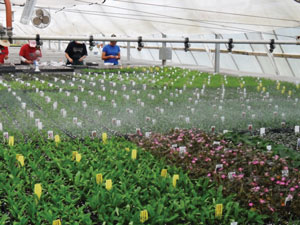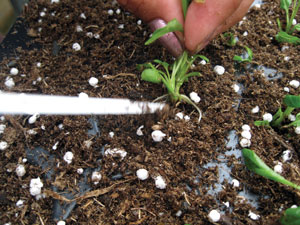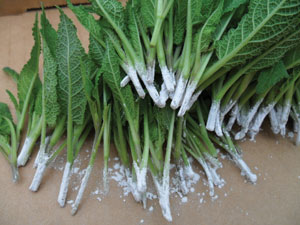6/23/2011
Specs for Success
Chris Fifo

Advances in genetics and breeding techniques over the last decade have led to an explosion of new perennial varieties available to the commercial grower. Seed propagation of perennials can be challenging and sometimes take more time, planning and technical expertise than vegetative propagation to be successful.
Furthermore, many of the newer and unique perennial varieties are not available from seed. This makes vegetative propagation a viable and necessary option. Although propagation from root division is regularly used for some perennial varieties, it can be a slower process and lead to less consistency than other methods of vegetative propagation.
Three main sources of stock are commonly used for unrooted propagation and will be discussed with specific tips for success: 1) buying in tissue culture plantlets, 2) buying in unrooted cuttings, and 3) cuttings from your own stock plants. Regardless of your source for plant material, some details for setting up a vegetative program and the environment need to be considered.
Environmental specifics
Light. The optimum amount of light for rooting perennials is 4-6 mols per day. This is a relatively low light level so fairly heavy shade is needed in the summer. To put this in perspective, a typical sunny day in the Midwest would average 30 mols. Many automatic shade/heat retention curtains are not a high enough percentage shade (40-60%); therefore, additional shade over the propagation area is beneficial. Up to 75% can be necessary.
Temperature. A soil temperature of 70F-75F (21C-24C) day and night is optimum for rooting most perennial varieties. Bottom heat or some type of root zone heating is best when heat is needed.
Nutrition. Most varieties benefit slightly from feed on unrooted cuttings. Formulations such as 15-5-15, 17-5-17 or 20-10-20 can be applied at a concentration of 30-50 ppm nitrogen in the mist, or applied by hand at 150-200 ppm one or two times per week. Phlox paniculata and hibiscus benefit the most from feed, while the varieties listed in Table 1 can be adversely affected by feed.
Scheduling. Though perennials can be propagated any time of year, many need a cold treatment for consistent flowering. Therefore many varieties, especially spring bloomers, should be propagated during the summer months to reach proper maturity before cold treatment.
Mist. This is commonly supplied from a boom, but any system for misting cuttings will work as long as the frequency of the mist cycle is adjustable. Depending on temperature, light and humidity, the mist cycle can be as often as every eight minutes or as long as one hour apart. The goal for misting is to provide just enough moisture to the leaves to keep the cutting turgid, but not saturate the media. The frequency of the mist cycle is also variety dependent. Some perennial varieties will not root consistently or will become diseased if misted too often (see Table above). The leaves on these varieties should be allowed to dry slightly in between misting cycles. Other crops, such as Sedum and Ivy, do not need to be misted.
Tissue culture
Many suppliers now offer a large selection of tissue culture (TC) perennials. Being a relatively new method of propagation, some growers would be a little wary of it, but there are several advantages over traditional cuttings:
- They are already rooted, which makes them quicker to become established.
- Because roots have been initiated, they require less mist than unrooted cuttings and can be propagated without a boom if humidity levels can be kept above 90% to 95%. One way to accomplish this would be to cover the trays with a lightweight germination fabric. This will let water and light through while maintaining high humidity.
- Since they are produced in a lab, TC plantlets are generally insect, virus and disease free.
Nutrient agar is sometimes present on the roots and should be removed by gently shaking or rinsing in warm water. Using a small stake or other tool, gently push the roots into the media and place in a lower mist area or under germination fabric. Be sure all roots are covered and humidity remains high until new roots are initiated. A mistake here can be costly as TC usually cost 50 to 75 cents a piece. Close attention is required to avoid losses.
Buying in unrooted cuttings
Unrooted cuttings (URC) are available from many sources and are generally less expensive than rooted tissue culture. They are neatly arranged in plastic bags and packaged in foam-insulated boxes with cooling gel packs. Unpack cuttings immediately upon arrival and be aware of the temperature inside the box. If the cool packs are melted or the cuttings are frozen, which is not common, notify your supplier and inspect the material for damage.
If the cuttings are a little droopy when they are unpacked, they can be misted and kept in a cool, shady location for an hour or two until they perk up. Some varieties, such as salvia and polemonium, may have large lower leaves which should be removed before sticking.
Inspect the cuttings for signs of disease or insect damage. If either is suspected, it’s a good idea to keep these crops separate from others in the greenhouse. Treat with a broad-spectrum fungicide if necessary and use a yellow sticky card to monitor for insects. If you intend to continue to propagate these cuttings, test for virus, as well. At Swift Greenhouses Inc., we test all incoming URC for four primary viruses using Agdia virus test kits.
 Taking cuttings from your own stock plants
Taking cuttings from your own stock plants
Dedicated facilities are not necessary for stock plant production, though they are helpful for clean cutting production. Initial cuttings can be obtained from leftover stock, or stock grown specifically for cuttings. Once these cuttings are established, they become your stock plants and cuttings can be harvested.
There are several key considerations for obtaining vigorous cuttings and consistent rooting from your stock plants.
- Sanitation is critical. All tools should be sterilized with alcohol and hands should be washed regularly. Sanitary footbaths are beneficial at all entry points into a propagation house. Avoid propagating diseased or virus-infected plants.
- Maintain a healthy stock plant. Keep the plants well fed, but not soft. A feed such as 20-10-20 can produce excessively soft cuttings which often do not root consistently. Instead, use a formulation such as 17-5-17 or 15-5-15 at 150 to 200 ppm as necessary. And don’t forget the micronutrients! We have found cuttings taken from stock plants fed with up to 50% greater micronutrients based on the amount of iron in standard fertilizer formulations can root quicker and more consistently than those with marginal or deficient levels of micronutrients.
- Avoid cuttings that have set bud. These do not root consistently, if at all. If a stock plant has initiated flowering, the buds can be removed and the stock plant regrown for vegetative cuttings. Many perennial varieties flower under the long days of summer and it can be difficult to avoid flowering. This includes Phlox paniculata, sedum Autumn Joy, plumbago and agastache. These varieties would need to be cut before late May or after mid October.
- Rooting hormone can hasten rooting on difficult varieties. IBA is the active ingredient in most rooting agents and comes in several concentrations from 0.1% to 0.8%. Powder should be used since some liquid formulations contain alcohol, which can burn cuttings. The general recommendation would be to use the lowest concentration that is effective. Salvia, geranium, baptisia, clematis and akebia vine are some of the varieties which benefit most from a hormone dip at higher concentrations.
- Avoid cutting from a stressed plant. Whether stress is caused by disease, chemicals, insects or moisture, these cuttings will not be as vigorous. Also, it is better to take cuttings early in the day to avoid heat stress.
- Avoid cutting the same stock plant too many times. Depending on the variety, a stock plant should not be cut more than three to five times or the cuttings will lose vigor.
 Removing plants from mist
Removing plants from mist
Once your tissue culture or cuttings have initiated new roots, promptly remove them from the mist area (Stage 1), but continue to provide high humidity and extra care (Stage 2). Once they are established and growing (Stage 3), they can now become your new stock.
A note of caution: Always be aware of and respect plant patents. Propagating patented plant material without the proper license can elicit a visit from the “plant police,” which can be very costly.
For most perennial producers, a combination of these three methods of production will best suit your vegetative needs. Purchasing URCs is usually the most economical method for producing vegetative perennials, but not all varieties can be done this way, making it necessary to maintain your own stock on certain varieties, or obtain TC on others.
Even with a successful vegetative program, many perennials are propagated most successfully with seed. Look for a future article in
GrowerTalks where we will discuss the details of propagating perennials from seed.
GT
Chris Fifo is Technical Services Advisor for Swift Greenhouses, Inc. in Gilman, Iowa. He can be reached at chrisf@swiftgreenhouses.com. For an expanded list of long-day perennials and lighting information go to
www.swiftgreenhouses.com.